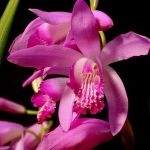| Common Name: |
Bletilla |
| Botanical Name: |
Bletilla striata syn. Bletilla hyacinthina |
| Genus: |
Bletilla |
| Family: |
Orchidaceae |
| Native Location: |
China, Japan |
| Cultivation: |
Well-drained, rich soil, with added peat, or peat substitute, and leaf mold, in shade or partial shade. Provide ample moisture in the growing season and keep on the dry side when dormant. Slugs may damage young leaves. Aphids and spider mite are often a problem under cover. |
| Propagation: |
By division or offsets of pseudobulbs in early spring. |
| Harvest: |
Pseudobulbs are lifted when dormant, and sliced and dried for use in decoctions and powder. |
| Variations: |
var. japonica f. gebina (syn. f. Alba
has white flowers
Variegata
Has white-striped leaves. |
| Height: |
30-60cm (12-24in) |
| Width: |
20-30cm (8-12in) |
| Hardiness: |
Z6-10 |
| Parts Used: |
Pseudobulbs. |
| Properties: |
A bitter, sweet and sour herb that checks bleeding, controls bacterial infection, reduces swelling, and promotes healing. |
| Medicinal Uses: |
Internally for hemorrhage of the lungs or stomach (e.g., in tuberculosis, gastric ulcer), uterine bleeding, and nosebleeds. Externally, often mixed with sesame oil, for burns, bleeding injuries, abscesses, and sores. |
| Bibliography: |
Encyclopedia of Herbs by Deni Brown Copyright © 1995, 2001 Dorling Kindersley Limited Pp 144-145 |
